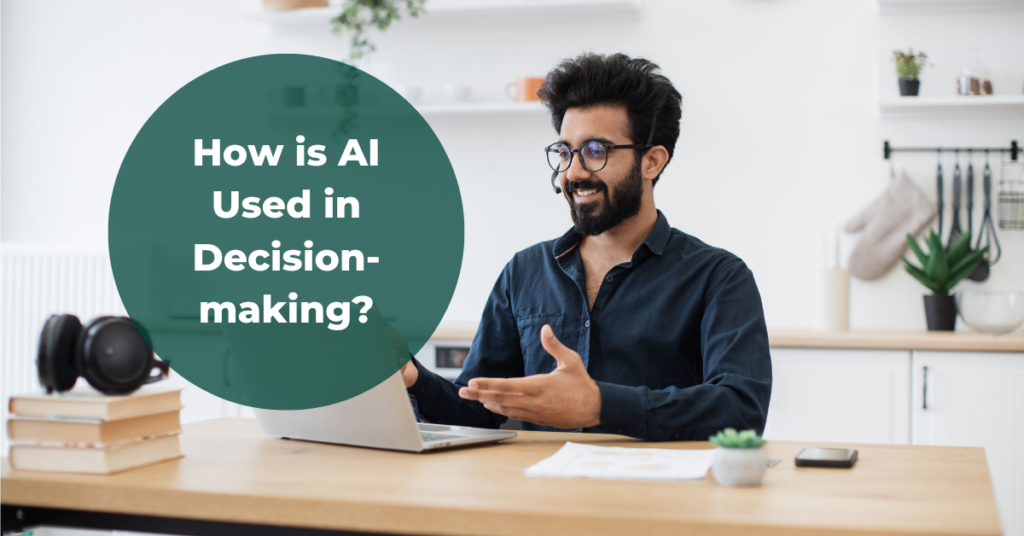
How is AI Used in Decision-making?
In the ever-evolving landscape of technological advancements, Artificial Intelligence (AI) stands out as a beacon of transformative power, significantly impacting the way decision intelligence is implemented across industries. The integration of AI into decision-making processes marks a paradigm shift. AI’s capacity to analyze colossal datasets and discern patterns has redefined decision-making. Whether it’s optimizing business strategies or tailoring user experiences, decision intelligence in AI has become the linchpin for navigating the complexities inherent throughout business analytics.
This blog looks to unravel the symbiotic relationship between AI and decision-making, shedding light on its profound influence, the mechanics it employs and the intricacies of generative AI.
Influence of AI in Decision-Making
Artificial intelligence has emerged as a transformative force in decision-making across various domains, offering unparalleled advantages in efficiency, accuracy and innovation. One of the primary ways AI aids decision-making is through data analysis. AI systems can process vast amounts of data at speeds beyond human capability, identifying patterns and trends that may elude human observers. This enables more informed and data-driven decision-making, minimizing the reliance on intuition alone.
Additionally, AI contributes to decision-making by automating routine tasks and processes. Repetitive and time-consuming activities can be delegated to AI algorithms, freeing up human resources to focus on more complex and strategic aspects of decision-making. This not only accelerates the decision-making process but also reduces the risk of human errors associated with monotonous tasks. Machine learning algorithms, a subset of AI, enhance decision-making by continuously learning and adapting from data inputs. These algorithms can predict future outcomes based on historical data, providing valuable insights for decision-makers. In sectors such as finance and healthcare, predictive analytics powered by AI can assist in risk assessment, resource allocation and even disease diagnosis.
Furthermore, AI facilitates personalized decision support. By analyzing individual preferences, behaviors and historical interactions, AI systems can tailor recommendations and suggestions to meet the specific needs of users. This personalization enhances the user experience and empowers individuals to make decisions aligned with their preferences. In complex situations, AI excels in scenario analysis and simulation. Decision-makers can utilize AI models to simulate various scenarios, assessing potential outcomes and risks before making a final decision. This proactive approach minimizes uncertainties and enables better preparation for different contingencies.
Algorithms Role in AI:
Algorithms play a central and highly influential role in AI decision-making processes. An algorithm, in the context of AI, is a step-by-step set of instructions or rules that a computer follows to perform a specific task or solve a particular problem. In decision-making, algorithms serve as the backbone for various AI models, enabling them to analyze data, learn patterns, make predictions and ultimately contribute to informed decision-making. Here are the main three algorithms used in AI decision-making:
1. Decision Trees: Decision trees serve as hierarchical decision-making structures, breaking down complex problems into a series of manageable choices, particularly effective for classification tasks.
2. Random Forest: Random Forest, an ensemble learning technique, elevates decision-making accuracy by combining multiple decision trees to mitigate overfitting.
3. Neural Networks: Modeled after the human brain, neural networks excel in pattern recognition, making them invaluable for decision-making tasks like image and speech recognition.
Generative AI in Decision-Making
Generative AI, a subset of artificial intelligence, is transforming decision-making by offering creativity and innovation. Models like GPT can generate new ideas, simulate scenarios and automate text creation. This aids in personalized recommendations, robust decision-making and efficient data augmentation for training models. Despite its benefits, ethical considerations and content validation remain essential for responsible use. As generative AI evolves, its influence on decision-making is marked by its capacity to provide novel solutions and enhance various industries.
Pros of Decision-Making with AI:
1. Efficiency: AI streamlines decision-making processes, saving valuable time and resources.
2. Data-Driven Insights: AI taps into vast datasets, uncovering nuanced insights often overlooked by traditional methods.
3. Consistency: AI ensures a standardized approach to decision-making, mitigating human biases and promoting consistency.
Cons of Decision-Making with AI:
1. Bias Concerns: If trained on biased datasets, AI systems may perpetuate or exacerbate existing biases.
2. Lack of Intuition: AI lacks human intuition, potentially struggling with decisions requiring emotional intelligence.
3. Dependency Risks: Overreliance on AI may lead to a lack of human oversight, overlooking crucial contextual factors.
Use AI in your Decision-Making Processes
As we traverse the landscape of decision-making with AI, it becomes evident that this technological synergy holds the key to a future where decisions are not only efficient but also driven by comprehensive insights. The journey is an exploration into the harmonious blend of human and machine intelligence, redefining how we perceive, analyze, and act upon the multitude of choices that shape our world. The horizon of decision-making with AI is both promising and fascinating, ushering in an era where innovation converges with strategic acumen.


